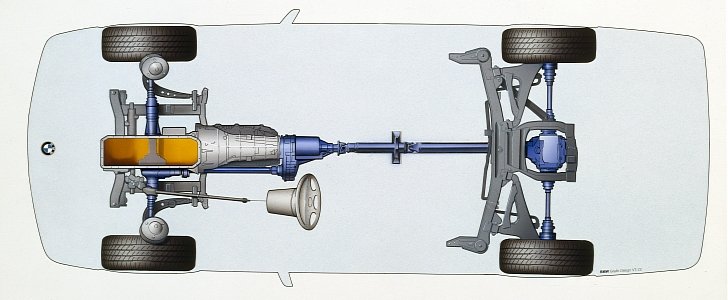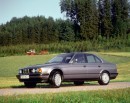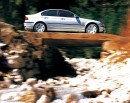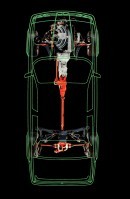This year, BMW is celebrating 30 years of xDrive models, but truth be told the all-wheel drive system wasn’t always offered under this name. As a matter of fact, the first all-wheel drive car from the Bavarian manufacturer was called BMW 325i "Allrad" and was a lot more different than you might imagine today.
Looking back at the three decades of all-wheel drive madness, we wandered through its history and wanted to share with you how everything evolved during this time. That being said, we are now going to go back to 1985 and take a look at the Frankfurt Motor Show.
In the center of the BMW stand lies the first ever all-wheel-drive 3 Series and the first ever all-wheel-drive car to have the blue and white badge on it. As we said earlier, it was the 325i "Allrad" model that was soon to evolve into the 325Xi, and later to be found only in Touring guise.
That model used a system that had a transfer case, which could lock up depending on the needs of the car. Usually, 67 percent of the power would be sent to the rear wheels, while 33 percent went to the front axle.
The first upgrade the all-wheel drive system received came in 1991 in the shape of the BMW 525iX, and moved from a mechanical version to an electronically controlled one. Basically, the power split was electronically controlled and the system had multi-plate clutches that had a different power split ratio.
Unlike its predecessor, the rear axle now received a bit less power and the front a bit more. Basically, there was 36 percent of it going up front and 64 percent to the rear. Power was split seamlessly depending on driving conditions.
Initially, a hydraulic system was desired, being regarded as more viable than an electronic one, but in the end, engineers went with the latter that also allowed the car to use selective braking intervention.
For the brakes to cut in, the system used readings from the ABS system, brake status, engine speed and throttle valve position to evaluate the driving conditions.
Of course, going with an electronic system back then offered BMW the upper hand in how fast the power was delivered and how the handling was affected. This was even more visible during wet laps or in the heavy snow outside the track. Luckily, customers weren’t forced to go with the Touring model alone this time, as sedans were also available with the all-wheel-drive alternative.
After all, it was the first time the Munich-based manufacturer built such a large vehicle, that thrashed every value they claimed to have and they had to make sure people were impressed. And if the design wasn’t cutting it, it had to be the way it drove.
Therefore, the all-wheel-drive system played a big part in the success the X5 recorded. This time, the engineers went for a planetary gear system that split the drive power in a ratio of 38:62 percent between the front and rear wheels.
At the same time, electronic systems such as DSC (Dynamic Stability Control), ADB-X (Automatic Differential Brake) and HDC (Hill Descent Control) were all working together to handle the challenges ahead.
The same system was then adapted for the BMW 3 Series in 2000, and starting with the new millennium, all AWD cars with the blue and white roundel on the hood used it.
Seeing the success the X5 recorded, another SAV was built in the shape of the X3. Being more compact and more agile, this one too needed a proper all-wheel drive system to send the power to all four corners of the car.
Other sensor data was included in the mix this time, such as the steering angle, accelerator position and lateral acceleration, to make it the first "intelligent" all-wheel-drive system in the industry. Back then, it was also the only one to use such gimmicks.
It was also a move from the conventional, the standard of those days, due to the way the car reacted when a wheel lost grip. Back then, the norm was that the AWD systems would change the way power was distributed only when a wheel was already spinning out of control. With xDrive, BMW tried to offer a version that was attempting to react proactively, or before the wheel actually started losing grip. This was done by detecting the risk of oversteer or understeer.
Just as it was the case with the X5 and its AWD system, xDrive was implemented and adapted to almost all models of the early 2000s, including the 3 Series and 5 Series for those who wanted its added practicality.
In 2007 it was time for the BMW X6 to show its face for the first time at the Frankfurt Motor Show. This was a first not only for BMW but also for the industry, this being the world’s premier Sport Activity Coupe. By 2008, the car was on sale and it used a different version of xDrive than what we knew until then.
Unlike its predecessor that used xDrive in conjunction with DSC, this one added DPC to its list of data suppliers. DPC stands for Dynamic Performance Control and it varies the split between the front and rear axles when cornering.
It was this system that was later used on the X5 M and X6 M models, the first cars with the M badge on them that sent power to all corners of the vehicle. That wasn’t it, though, as the new BMW X1, launched in 2009, was also on the receiving end of this technology.
Fitted with Performance Control, this version of the xDrive intelligent system could brake the inside wheel when making a turn while simultaneously increasing engine power, simulating a torque vectoring function.
Over the years, research and development in the field never stopped and in 2009 we saw the first BMW 7 Series fitted with xDrive come out and in the Spring of 2012, the same system was offered on Coupe and Convertible models for the first time, thanks to the 6 Series range.
This one works differently and it is the first time a system from BMW’s range sends most of its power to the front wheels instead of the rear ones.
Basically, power from the front drive to the rear axle is transferred thanks to an angular gear on the front differential and a two-part joint shaft that are called "Power Take-Off." The heart of the entire system is an electro-hydraulic multiple-disk clutch (Hang-On) fitted inside the rear axle drive. Its job is to vary the torque distribution between the front and rear wheels via a hydraulic pump.
Up to 100 percent of the power and torque can be sent to the rear wheels if the situation demands it and the amount that gets sent over there is dictated by a pulse-width-modulated signal from the ECU.
Last but not least, the xDrive badge was applied to hybrid cars of the last few years. By that we’re referring to the i8, X5 xDrive40e and 225xe models that are all different in their own way.
The i8 uses two power sources to get its all-wheel drive character. Up front, you have an electric motor powering the axle while at the back you get a 1.5-liter 3-cylinder turbocharged engine that takes care only of the wheels atop of which it sits. When working together, the two are synchronized and offer incredible performance.
Then there’s the 225xe Active Touring car that uses a similar setup but mirrored, with the electric motor powering the rear axle and the internal combustion one the front wheels. Last but not least, the X5 xDrive40e has an intelligent hybrid power management system that works continuously to deliver the best performance as well as efficiency. Therefore, when only the electric motor embedded in the gearbox is sufficient for the car’s needs, the ICE unit stands still, the power being sent to all corners of the car.
The most recent car to introduce a novelty in the realm of all-wheel drive technologies is the 2016 7 Series. This is the first time a BMW model offers integral active steering along with xDrive. While this may be a first, future models are bound to pick up this tech, the G80 M5 probably being the first one.
In the center of the BMW stand lies the first ever all-wheel-drive 3 Series and the first ever all-wheel-drive car to have the blue and white badge on it. As we said earlier, it was the 325i "Allrad" model that was soon to evolve into the 325Xi, and later to be found only in Touring guise.
That model used a system that had a transfer case, which could lock up depending on the needs of the car. Usually, 67 percent of the power would be sent to the rear wheels, while 33 percent went to the front axle.
The first upgrade the all-wheel drive system received came in 1991 in the shape of the BMW 525iX, and moved from a mechanical version to an electronically controlled one. Basically, the power split was electronically controlled and the system had multi-plate clutches that had a different power split ratio.
Unlike its predecessor, the rear axle now received a bit less power and the front a bit more. Basically, there was 36 percent of it going up front and 64 percent to the rear. Power was split seamlessly depending on driving conditions.
Initially, a hydraulic system was desired, being regarded as more viable than an electronic one, but in the end, engineers went with the latter that also allowed the car to use selective braking intervention.
For the brakes to cut in, the system used readings from the ABS system, brake status, engine speed and throttle valve position to evaluate the driving conditions.
Of course, going with an electronic system back then offered BMW the upper hand in how fast the power was delivered and how the handling was affected. This was even more visible during wet laps or in the heavy snow outside the track. Luckily, customers weren’t forced to go with the Touring model alone this time, as sedans were also available with the all-wheel-drive alternative.
The rise of SUVs (SAVs)
Once the BMW X5 came out to play in 1999, a new version was needed for it since this was the company’s first SUV (or SAV as the Germans called it: Sport Activity Vehicle). This had to be a car that impressed with its dynamics, one that set the standard in the field, to make sure customers weren’t driven away.After all, it was the first time the Munich-based manufacturer built such a large vehicle, that thrashed every value they claimed to have and they had to make sure people were impressed. And if the design wasn’t cutting it, it had to be the way it drove.
Therefore, the all-wheel-drive system played a big part in the success the X5 recorded. This time, the engineers went for a planetary gear system that split the drive power in a ratio of 38:62 percent between the front and rear wheels.
At the same time, electronic systems such as DSC (Dynamic Stability Control), ADB-X (Automatic Differential Brake) and HDC (Hill Descent Control) were all working together to handle the challenges ahead.
The same system was then adapted for the BMW 3 Series in 2000, and starting with the new millennium, all AWD cars with the blue and white roundel on the hood used it.
Seeing the success the X5 recorded, another SAV was built in the shape of the X3. Being more compact and more agile, this one too needed a proper all-wheel drive system to send the power to all four corners of the car.
Electronics start to take over
In 2003, that system arrived and it was called xDrive for the first time. Based on the multi-plate clutch system we told you about above, it used the same layout but worked in tandem with the DSC and was continuously adapting the power split between axles, depending on the situation at hand.Other sensor data was included in the mix this time, such as the steering angle, accelerator position and lateral acceleration, to make it the first "intelligent" all-wheel-drive system in the industry. Back then, it was also the only one to use such gimmicks.
It was also a move from the conventional, the standard of those days, due to the way the car reacted when a wheel lost grip. Back then, the norm was that the AWD systems would change the way power was distributed only when a wheel was already spinning out of control. With xDrive, BMW tried to offer a version that was attempting to react proactively, or before the wheel actually started losing grip. This was done by detecting the risk of oversteer or understeer.
Just as it was the case with the X5 and its AWD system, xDrive was implemented and adapted to almost all models of the early 2000s, including the 3 Series and 5 Series for those who wanted its added practicality.
In 2007 it was time for the BMW X6 to show its face for the first time at the Frankfurt Motor Show. This was a first not only for BMW but also for the industry, this being the world’s premier Sport Activity Coupe. By 2008, the car was on sale and it used a different version of xDrive than what we knew until then.
Unlike its predecessor that used xDrive in conjunction with DSC, this one added DPC to its list of data suppliers. DPC stands for Dynamic Performance Control and it varies the split between the front and rear axles when cornering.
It was this system that was later used on the X5 M and X6 M models, the first cars with the M badge on them that sent power to all corners of the vehicle. That wasn’t it, though, as the new BMW X1, launched in 2009, was also on the receiving end of this technology.
Fitted with Performance Control, this version of the xDrive intelligent system could brake the inside wheel when making a turn while simultaneously increasing engine power, simulating a torque vectoring function.
Over the years, research and development in the field never stopped and in 2009 we saw the first BMW 7 Series fitted with xDrive come out and in the Spring of 2012, the same system was offered on Coupe and Convertible models for the first time, thanks to the 6 Series range.
FWD-based systems and integral steering
Once the X4 was launched, the xDrive system was further improved but the basis remained intact. The new X4 and X3 models are using a system that mimics torque vectoring using the brakes. In 2014, the 2 Series range introduced the first ever xDrive system that worked with a transversely mounted engine. Of course, we're referring only to the Active Tourer and Gran Tourer versions, the Coupe and Convertible alternatives being safe from this change.This one works differently and it is the first time a system from BMW’s range sends most of its power to the front wheels instead of the rear ones.
Basically, power from the front drive to the rear axle is transferred thanks to an angular gear on the front differential and a two-part joint shaft that are called "Power Take-Off." The heart of the entire system is an electro-hydraulic multiple-disk clutch (Hang-On) fitted inside the rear axle drive. Its job is to vary the torque distribution between the front and rear wheels via a hydraulic pump.
Up to 100 percent of the power and torque can be sent to the rear wheels if the situation demands it and the amount that gets sent over there is dictated by a pulse-width-modulated signal from the ECU.
Last but not least, the xDrive badge was applied to hybrid cars of the last few years. By that we’re referring to the i8, X5 xDrive40e and 225xe models that are all different in their own way.
The i8 uses two power sources to get its all-wheel drive character. Up front, you have an electric motor powering the axle while at the back you get a 1.5-liter 3-cylinder turbocharged engine that takes care only of the wheels atop of which it sits. When working together, the two are synchronized and offer incredible performance.
Then there’s the 225xe Active Touring car that uses a similar setup but mirrored, with the electric motor powering the rear axle and the internal combustion one the front wheels. Last but not least, the X5 xDrive40e has an intelligent hybrid power management system that works continuously to deliver the best performance as well as efficiency. Therefore, when only the electric motor embedded in the gearbox is sufficient for the car’s needs, the ICE unit stands still, the power being sent to all corners of the car.
The most recent car to introduce a novelty in the realm of all-wheel drive technologies is the 2016 7 Series. This is the first time a BMW model offers integral active steering along with xDrive. While this may be a first, future models are bound to pick up this tech, the G80 M5 probably being the first one.




































































































